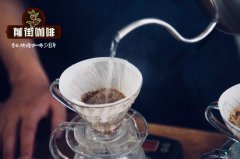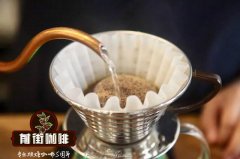When the price of Arabica beans has fallen to a 13-year low, why has the price of the coffee we drink never dropped?

Professional coffee knowledge exchange more coffee bean information please follow the coffee workshop (Wechat official account cafe_style)
For Chinese people, coffee as a drink is constantly integrated into our daily life. People's understanding of "coffee" has become more specific and can return its essence to crops. We will know that coffee beans are the seeds of coffee cherries and need to be picked by farmers from coffee trees; different varieties of coffee beans taste different, and so are beans from different places.
Like planting rice and vegetables in fields and fruits in orchards, the prices of coffee beans in crops will fluctuate as a result of the harvest. This year, the international price of Arabica coffee beans-the "Arabica" we saw and heard in various coffee shops, McDonald's and KFC, 7-11 and the whole family-is falling sharply. Does this mean that we can enjoy more good and cheap coffee?
Coffee is not only a crop, but also a commodity.
Coffee beans from Brazil are believed to have been drunk by many people, and their balanced flavor with creamy, nutty, chocolate and caramel flavors is acceptable to even those who taste the coffee for the first time. However, the output of coffee beans in this country is a key factor affecting the overall international coffee price.
Although coffee is a crop, it is also a traded product. The transaction price of Arabica beans is the so-called C-Price (American coffee price), which affects the purchase price of coffee. Over the past few years, global coffee production has risen, while the price of Arabica beans has fallen again and again. This year, Brazil, which accounts for 1/4 of the world's coffee supply, continues to export heavily, which is believed to be the most important reason why the price of Arabica beans has fallen to a 13-and-a-half-year low.
There is a bumper harvest of coffee beans, but it doesn't seem to be something to be happy about. But for speculators, it is a good opportunity to make a profit. Greggs, a supplier of coffee beans to McDonald's, said some food companies were using the slump as an opportunity to lock in low prices to hoard coffee beans and wait for prices to rise again.
So can we have cheaper coffee?
Financial expert Kevin Odyssey 39 Leary once said, "it's stupid to buy coffee for more than 30 yuan." other financial experts have pointed out that young people have to quit coffee if they want to get rid of the "moonlight". After all, whether it's a large chain coffee shop or a boutique coffee shop hidden in an alley, a cup of coffee is often more than 30 yuan.
Nowadays, the price of raw coffee beans as a raw material has fallen so low, can we enjoy the favor of consumers?
The answer is no.
In fact, people who drink coffee in coffee shops spend more money on a cup of coffee than they did in 2011. Take Starbucks as an example, the price of a cup of espresso in the UK has risen by about 20%; the price of some domestic Starbucks products also rose slightly at the end of last year. The price increase is made by Starbucks after careful evaluation and comprehensive consideration of rent, logistics, store facilities, manpower, product development and customer experience innovation.
Seeing this, smart readers probably know it at a glance. The money we spend on coffee is actually spent more on other places than on the coffee itself. Even if the price of Arabica coffee futures falls sharply in the world, it has nothing to do with whether we can get a cup of coffee more cheaply.
Can Little Red Cup really restore the price of a cup of coffee?
At the same time, coffee shop owners are more troubled by rising rents and equipment prices, even if Quinling, the wife of Jay Chou, the star IP, has closed her own cafe at high rents. In order to balance the cost, the shopkeeper had to choose to raise the price.
Not only won't it be cheap, but we won't even get better coffee.
No one has been hurt most by the collapse in coffee prices than the coffee farmers. Looking straight at the data, the price of Arabica coffee beans on the ICE Futures Exchange has been around 93 cents a pound, but that is much lower than the production costs of many coffee farmers in Central America, who need $1.20 to $1.50 a pound to break even.
A large number of farmers give up their coffee for a living and even turn to grow illegal crops. Well-known coffee producing areas such as Kenya and Colombia are introducing various relief measures in response to this devastating low-price shock. It is worth mentioning that the high quality of boutique coffee does not improve this low price. Even if farmers spend a lot of effort and cost to produce boutique coffee, they may not be able to get their money back.
What will really pay for thousands of coffee beans from coffee farmers is for corporate roasters from large channels such as Nestl é and Starbucks, even if they require coffee beans to meet certain professional quality standards. but there will be no more extra pay based on the so-called cup test scores. In order to survive, coffee farmers are likely to give up producing boutique coffee or even stop growing coffee.
Coffee, drink and cherish
The millennials who grew up with Starbucks are driving the coffee industry to flourish. In addition to Starbucks, there are emerging Internet coffee companies like Luckin Coffee and boutique coffee shops large and small, from cold extract to nitrogen to a variety of innovative drinks, all of which are driving the trend of the coffee market.
On the other hand, the price of coffee beans plummeted and coffee farmers were so mired in unfair trading that they could not even afford to buy a cup of coffee. At the same time, 60% of the world's wild coffee varieties, including our favorite Arabica species, are at risk because of climate change, the loss of deforestation habitats, and the threat of diseases and pests.
There is no doubt that coffee will be a more and more popular drink. However, its future is not necessarily bright.
Photo Source: Internet
Important Notice :
前街咖啡 FrontStreet Coffee has moved to new addredd:
FrontStreet Coffee Address: 315,Donghua East Road,GuangZhou
Tel:020 38364473
- Prev

What are the grades of Kenyan coffee beans?
Coffee beans in Kenya are graded by particle size, usually divided into AA, AB, C, T, TT, MH, ML and other grades, and the quality is also in descending order. AA+ is the highest grade of Kenyan coffee, and only batches with particularly good flavor and few defects are allowed to do so. In the 1930s, a Tanzanian species was used by the Scott Lab in Kenya.
- Next

What coffee producing areas are there in Asia? What are the most common varieties of coffee in Asia?
Professional coffee knowledge exchange more coffee bean information Please follow Coffee Workshop (Wechat official account cafe_style) Asia, perhaps a relationship close to the equator, the impression is always sunny, rice, spices, tropical fruits and Buddhism, this is our general understanding of Asia, in fact, this impression is not far from the personality of Asian coffee. The local conditions determine the coffee style.
Related
- What documents do you need to go through to open a coffee shop? coffee shop coffee shop certificate processing process
- How to purchase Coffee beans in small Cafe how to choose a suitable supplier for domestic Coffee supply Company
- How to drink Starbucks Fragrance White Coffee? how to make Australian White Coffee? what Italian coffee beans are recommended?
- The Story of Flora Coffee: the name of Flora Coffee Bean and the implication of the Flowers on Florna Coffee
- How much does a cup of coffee cost? How much is the profit of a cup of coffee? What is the profit of the coffee shop in a year?
- Yunnan small Coffee, known as "fragrant Coffee", introduces the characteristics of Alpine Arabica Coffee producing areas in Yunnan, China
- 2023 latest Starbucks full menu price list how much is a cup of Starbucks coffee what is better to drink the most popular hot and cold drinks recommended
- Starbucks different kinds of Coffee Price list Starbucks menu 2023 Top Ten Best drinks in Starbucks
- Starbucks Spring praise Comprehensive matching Coffee Bean theme Story Packaging implication and taste description
- The cost of a cup of coffee latte American coffee cost price and selling price

